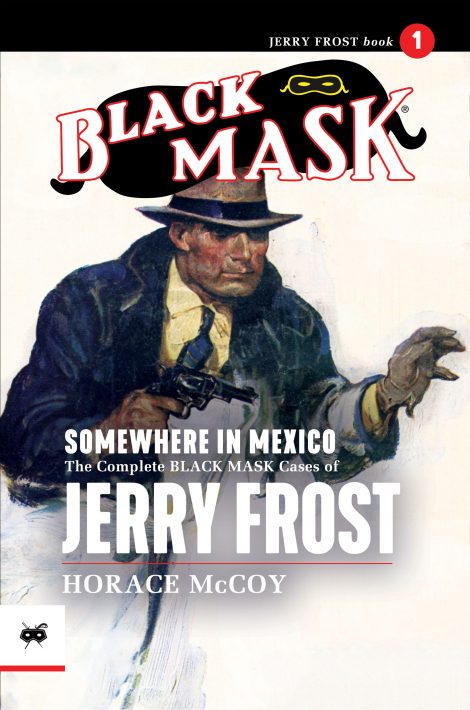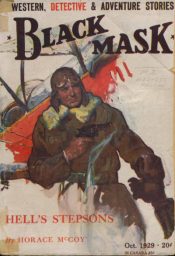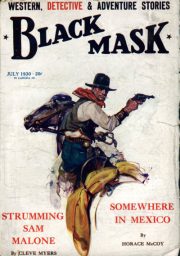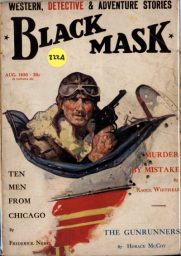
Black Mask magazine is considered to be one of the most influential of pulp magazine along with Weird Tales, Astounding Stories/Science Fiction, and Argosy. All had a profound impact on popular fiction and culture.
Black Mask was the magazine that changed crime-mystery-detective fiction from the locked room to the mean streets. Dashiell Hammett and Carroll John Daly started the hard-boiled transformation in the early 1920s. “Cap” Joseph Shaw remodeled the magazine when he took over as editor in 1926. The magazine cover had “Western, Detective & Adventure Stories” above the title. The first issue with Shaw as editor had a “Captain Kettle” adventure by C. J. Cutliffe-Hyne and also the serial “The Man-Eaters of Tsavo” by J. H. Patterson (?).
Shaw changed the magazine from The Black Mask to Black Mask with the May 1927 issue. The number of western scenes on the covers decreased and crime/gangster covers increased. Shaw encouraged series characters. If you look at the The Crime, Mystery, & Gangster Fiction Magazine Index, you will notice 2/3- ¾ of contents of a late 1920s issue of Black Mask were part of series.
One of those series was the “Jerry Frost” series by Horace McCoy (1897-1955). McCoy is remembered today for the novel They Shoot Horses, Don’t They? McCoy was a WW I veteran, theater actor, and newspaper man. He started in the pulp magazines in 1926 writing westerns. His first story in Black Mask was in 1927. After a two year absence, he returned with “Dirty Work,” the first of the Jerry Frost stories in September 1929.
Jerry Frost is a veteran ace pilot from WW1, a mercenary in Central America, and now an Air Texas Ranger. That is the hook of the series. Black Mask had been running some aviation stories by Raoul Whitfield. They must have been popular enough for “Cap” Shaw to want more. There were 14 stories in Black Mask from 1929 to 1934. Horace McCoy left the pulps after that and went to Hollywood.
America, and now an Air Texas Ranger. That is the hook of the series. Black Mask had been running some aviation stories by Raoul Whitfield. They must have been popular enough for “Cap” Shaw to want more. There were 14 stories in Black Mask from 1929 to 1934. Horace McCoy left the pulps after that and went to Hollywood.
Somewhere in Mexico: The Complete BLACK MASK Case of Jerry Frost contains the first seven stories.
Contents:
Dirty Work September 1929
Hell’s Stepsons October 1929
Renegades of the Rio December 1929
The Little Black Book January 1930
Frost Rides Alone March 1930
Somewhere in Mexico July 1930
The Gun-Runners August 1930
John Wooley who knows his detective pulp fiction provides an entertaining and informational introduction to the book. The stories are novelette length. “Dirty Work” introduces Frost and the death of his Air Rangers by the Black Ship Gang. “Hell’s Stepsons” introduces Frost’s backup in the series: four fliers who are WW1 veterans- two Americans, one Englishman, and one German.
Each story has the Air Rangers dealing with high speed/high tech airplanes by a crime organization involved in all sorts of things like liquor and gun smuggling. Captain Jerry Frost also has to deal with corruption in Texas towns.
by a crime organization involved in all sorts of things like liquor and gun smuggling. Captain Jerry Frost also has to deal with corruption in Texas towns.
I had read one of the Jerry Frost stories in The Arbor House Treasury of Detective & Mystery Stories from the Great Pulps and scanned over another story in The Black Lizard Big Book of Black Mask Stories.
I have mentioned to Don Herron (Dashiell Hammett Tour) more than once on how little fiction from Black Mask has been reprinted. You can easily get Dashiell Hammett and Raymond Chandler’s fiction. For some reason, “Paul Cain” has been reprinted more than once though I don’t care for the prose. A couple of Raoul Whitfield novels have been reprinted and his great “Jo Gar” series written as “Ramon Decolta.” There have been a few widely spaced Black Mask anthologies. That’s it. A minuscule amount of fiction from Black Mask has been reprinted in comparison to Weird Tales or Astounding Science Fiction.
I will say that interest in Horace McCoy is due to his post-pulp novels, especially They Shoot Horses, Don’t They? That in turn is because of the well known movie. The Jerry Frost stories are pulpy. They were not so much like Hammett or Chandler but more on the level of a hero pulp. Jerry Frost is rather two dimensional. Hell’s Stepsons are hard to tell apart outside of the German. The writing is miles away from They Shoot Horses. Shaw did not include any stories by McCoy in The Hard Boiled Omnibus. William F. Nolan included one in The Black Mask Boys but supposedly did some rewriting. I had asked Nolan at Pulpfest one year about the charge that he rewrote a bunch of Max Brand stories for a paperback. He got rather defensive and told me only wrote a framing sequence to the title story that he was asked to do.
Still, I am glad I have read this book. I am curious if the writing became more sophisticated by 1934 when the series ended. I am curious about the serial “Man-Eaters of Tsavo” by J. H. Patterson from Black Mask 1926-1927.
Please give us your valuable comment